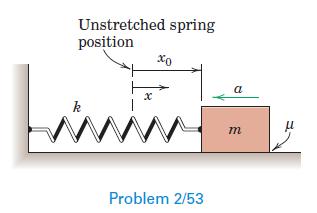The situation of Prob. 2/53 is repeated here. This time, use the values m = 5 kg,
Question:
The situation of Prob. 2/53 is repeated here. This time, use the values m = 5 kg, k = 150 N /m, μ = 0.40, and x0 = 500 mm and determine the final spring stretch (or compression) xƒ when the block comes to a complete stop. The sign on the μg term is dictated by the direction of motion for the block and always acts in the direction opposite velocity.
Data from Prob. 2/53
A block of mass m rests on a rough horizontal surface and is attached to a spring of stiffness k. The coefficients of both static and kinetic friction are μ. The block is displaced a distance x0 to the right of the un stretched position of the spring and released from rest. If the value of x0 is large enough, the spring force will overcome the maximum available static friction force and the block will slide toward the un stretched position of the spring with an acceleration a = μg − k/m x, where x represents the amount of stretch (or compression) in the spring at any given location in the motion. Use the values m = 5 kg, k = 150 N /m, μ = 0.40, and x0 = 200 mm and determine the final spring stretch (or compression) xƒ when the block comes to a complete stop.

Step by Step Answer:

Engineering Mechanics Dynamics
ISBN: 9781118885840
8th Edition
Authors: James L. Meriam, L. G. Kraige, J. N. Bolton





